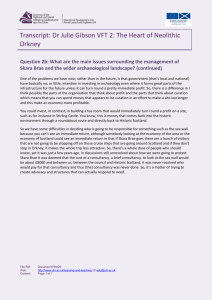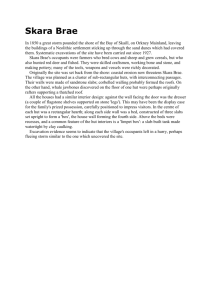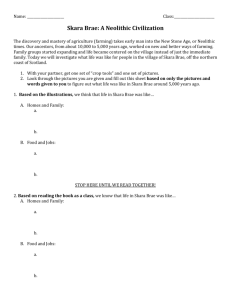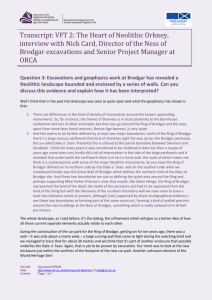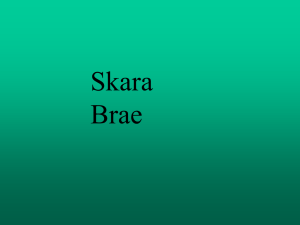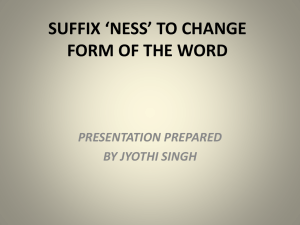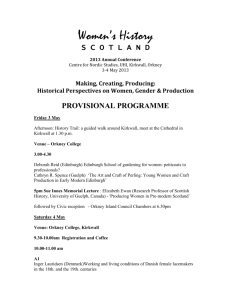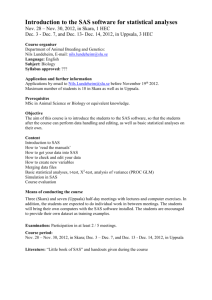Transcript: VFT 2: Orkney - Interview with Antonia Thomas, PhD
advertisement
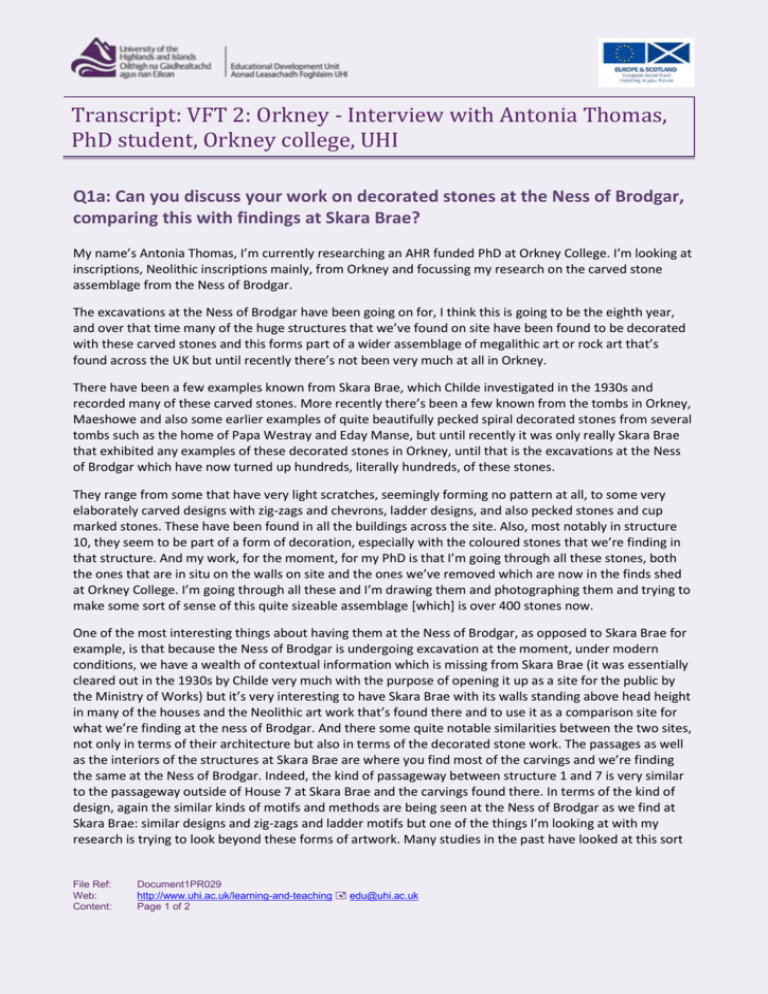
Transcript: VFT 2: Orkney - Interview with Antonia Thomas, PhD student, Orkney college, UHI Q1a: Can you discuss your work on decorated stones at the Ness of Brodgar, comparing this with findings at Skara Brae? My name’s Antonia Thomas, I’m currently researching an AHR funded PhD at Orkney College. I’m looking at inscriptions, Neolithic inscriptions mainly, from Orkney and focussing my research on the carved stone assemblage from the Ness of Brodgar. The excavations at the Ness of Brodgar have been going on for, I think this is going to be the eighth year, and over that time many of the huge structures that we’ve found on site have been found to be decorated with these carved stones and this forms part of a wider assemblage of megalithic art or rock art that’s found across the UK but until recently there’s not been very much at all in Orkney. There have been a few examples known from Skara Brae, which Childe investigated in the 1930s and recorded many of these carved stones. More recently there’s been a few known from the tombs in Orkney, Maeshowe and also some earlier examples of quite beautifully pecked spiral decorated stones from several tombs such as the home of Papa Westray and Eday Manse, but until recently it was only really Skara Brae that exhibited any examples of these decorated stones in Orkney, until that is the excavations at the Ness of Brodgar which have now turned up hundreds, literally hundreds, of these stones. They range from some that have very light scratches, seemingly forming no pattern at all, to some very elaborately carved designs with zig-zags and chevrons, ladder designs, and also pecked stones and cup marked stones. These have been found in all the buildings across the site. Also, most notably in structure 10, they seem to be part of a form of decoration, especially with the coloured stones that we’re finding in that structure. And my work, for the moment, for my PhD is that I’m going through all these stones, both the ones that are in situ on the walls on site and the ones we’ve removed which are now in the finds shed at Orkney College. I’m going through all these and I’m drawing them and photographing them and trying to make some sort of sense of this quite sizeable assemblage [which] is over 400 stones now. One of the most interesting things about having them at the Ness of Brodgar, as opposed to Skara Brae for example, is that because the Ness of Brodgar is undergoing excavation at the moment, under modern conditions, we have a wealth of contextual information which is missing from Skara Brae (it was essentially cleared out in the 1930s by Childe very much with the purpose of opening it up as a site for the public by the Ministry of Works) but it’s very interesting to have Skara Brae with its walls standing above head height in many of the houses and the Neolithic art work that’s found there and to use it as a comparison site for what we’re finding at the ness of Brodgar. And there some quite notable similarities between the two sites, not only in terms of their architecture but also in terms of the decorated stone work. The passages as well as the interiors of the structures at Skara Brae are where you find most of the carvings and we’re finding the same at the Ness of Brodgar. Indeed, the kind of passageway between structure 1 and 7 is very similar to the passageway outside of House 7 at Skara Brae and the carvings found there. In terms of the kind of design, again the similar kinds of motifs and methods are being seen at the Ness of Brodgar as we find at Skara Brae: similar designs and zig-zags and ladder motifs but one of the things I’m looking at with my research is trying to look beyond these forms of artwork. Many studies in the past have looked at this sort File Ref: Web: Content: Document1PR029 http://www.uhi.ac.uk/learning-and-teaching edu@uhi.ac.uk Page 1 of 2 Transcript: VFT 2: Orkney - Interview with Antonia Thomas, PhD student, Orkney college, UHI 05/06/13 of things as a means of encoding some sort of symbol or hidden meaning but actually, looking at the techniques of carving and the more embodied aspects of working the stone, in addition to the contextual information from the excavations, [we are] forming a much more rounded picture of how these stones might have been meaningful in the Neolithic. The interesting thing about the Ness is the size of the assemblage to start with – it’s quite incredible and part of that can be explained by the fact that it is being dug now, so we’re finding things in rubble contexts and in demolition debris and rubble spreads that probably with Skara Brae would just have been cleared out but then with Skara Brae, with the level of preservation you would expect to have a lot more in situ and at the ness of Brodgar there is a huge amount in situ. So in that sense the Ness of Brodgar exceeds the assemblage at Skara Brae. In terms of the type of carvings and inscriptions, they are very similar. Where the Ness of Brodgar differs is in the pecked decoration, the cup marked stones and also the Pict dressing that we’re finding on some of the stonework and that’s not really in evidence at Skara Brae. So I think a lot of it is the visibility and it is to do with it being excavated under modern conditions, and because we’ve found so many at the Ness, we’re looking for them. But then, Skara Brae has been looked [at] again by LeckieShepherd, Elizabeth Shee Twohig (as part of her corpus on megalithic art) and they did find some more but not anywhere near the number you’d expect if it was going to compare with the Ness of Brodgar; so there is something quite exceptional going on there. File Ref: Web: Content:: Document1 http://www.uhi.ac.uk/learning-and-teaching edu@uhi.ac.uk Page 2 of 2
